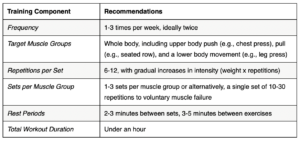Author: David Propst, PA-C
In this blog post, we will discuss the importance and underutilization of the SARC-F screening tool for sarcopenia, especially in primary care settings. We will also delve into the significance of resistance exercise training and nutritional interventions in managing this condition effectively.
What is Sarcopenia?
Sarcopenia is a muscle disorder involving loss of muscle mass and muscle function originally thought to occur solely due to the aging process. [1] Derived from the Greek words “sarx” (flesh) and “penia” (loss), sarcopenia aptly describes the atrophy or wasting of muscle tissue.[2,3] Although it is primarily associated with aging, the condition can also be exacerbated by physical inactivity, hormonal changes, chronic diseases, and malnutrition.[1,3,4]
Characterized by a decline in type II muscle fibers,[3] muscle strength, and muscle quality, sarcopenia’s onset and progression are influenced by various factors, both intrinsic and extrinsic. Its clinical manifestations include reduced muscle strength, fatigue, impaired mobility, and an increased risk for falls.[1,3,4]
Importantly, sarcopenia is not just an inevitable outcome of aging. It represents a distinct clinical condition with specific diagnostic criteria, which can include measurements of muscle mass, muscle strength, and physical performance.[1,3,4] Early detection and intervention are crucial for halting or even reversing its progression, thereby improving patient outcomes and overall health trajectory.
Why Sarcopenia Screening Is Imperative
Incidence of sarcopenia is at least 10% among individuals aged 60 and above.[1] Sarcopenia is associated with worsening outcomes in most chronic diseases, reduced ability to perform activities of daily living, an increased risk of the loss of independence, and an increased risk of premature death.[1,4] This condition is particularly problematic for those struggling with obesity, as they may concurrently suffer from or be at risk for sarcopenia. Ignoring potential links between these two conditions can lead to reduced quality of life, impaired function, and increased mortality rates.[1,4]
Utility of the SARC-F
The SARC-F screening tool is a quick, easy-to-use method to identify patients at risk for sarcopenia. It was introduced in 2013 by Drs. Malmstrom and Morley recognizing the importance of the identification of sarcopenia.[5] The five-question survey focuses on evaluating strength, assistance in walking, ability to rise from a chair, climbing stairs, and history of falls. A score equal to or greater than 4 is a significant indicator of sarcopenia, necessitating further evaluation.[1,4,5]
Implementing SARC-F in Primary Care: Practical Steps
Primary care providers should integrate the SARC-F as part of their routine assessments, especially in geriatric populations. Following a score of 4 or more on the SARC-F, additional assessments such as grip strength and gait speed may be performed; however, practitioners are encouraged to prescribe resistance exercise for anyone who may be at risk for sarcopenia.[1,4,5,6]
The Role of Resistance Exercise and Nutrition in Sarcopenia
One of the most effective ways to prevent the loss of muscle strength, function, and fat-free mass is through resistance exercise training. It plays a pivotal role in maintaining muscle function and mass.[1,2,4,6,7] Hurst et Al reviews the use of and implementation of resistance exercise for prevention and treatment of sarcopenia (Table 1).[6] Sufficient protein intake and creatine monohydrate supplementation can enhance the effects of resistance exercise with limited data suggesting benefits on their own.[1,4,6,7]
Table 1. Resistance Exercise Training Recommendations for Sarcopenia Prevention and Treatment

Data adapted from: Hurst C, Robinson SM, Witham MD, et al. Resistance exercise as a treatment for sarcopenia: prescription and delivery. Age Ageing. 2022;51(2):afac003. doi:10.1093/ageing/afac003
Addressing the Complex Issue of Sarcopenic Obesity
In patients who are obese, the risk of sarcopenia increases. Weight loss programs for such individuals should be carefully planned to prioritize the preservation of fat-free mass. Resistance exercise becomes especially critical in these cases, as it can mitigate the risk of muscle mass loss.[1,3,4,6,7]
Practical Tips:
– Screen all older adults for sarcopenia with the SARC-F.
– Prescribe properly dosed resistance exercise to prevent or treat sarcopenia. If you do not feel comfortable with this then refer to an appropriate allied health team member.
– In obese patients at risk for sarcopenia, combine weight loss strategies with resistance exercise and adequate protein intake.
– Monitor muscle function and mass before, during, and after any weight loss program.
Conclusion
– The SARC-F tool is a valuable asset for detection of probable sarcopenia and should be incorporated into routine assessments in primary care.[1,4,5]
– Resistance exercise training is the cornerstone for preventing muscle mass loss and should be part of the management plan for sarcopenia.[1,3,4,6,7]
– A multidisciplinary approach involving resistance exercise and nutritional strategies can yield optimal patient outcomes.[1,3,4,6,7]

References
- Cruz-Jentoft AJ, Bahat G, Bauer J, et al. Writing Group for the European Working Group on Sarcopenia in Older People 2 (EWGSOP2), and the Extended Group for EWGSOP2. Sarcopenia: revised European consensus on definition and diagnosis. Age Ageing. 2019 Jan 1;48(1):16-31. doi: 10.1093/ageing/afy169
- Rosenberg IH. Sarcopenia: origins and clinical relevance. J Nutr. 1997 May;127(5 Suppl):990S-991S. doi: 10.1093/jn/127.5.990S. PMID: 9164280
- Tanganelli F, Meinke P, Hofmeister F, et al. Type-2 muscle fiber atrophy is associated with sarcopenia in elderly men with hip fracture. Experimental Gerontology. 2021;144:111171. doi:10.1016/j.exger.2020.111171
- Bauer J, Morley JE, Schols A, et al. Sarcopenia: A Time for Action. An SCWD Position Paper, Journal of Cachexia, Sarcopenia and Muscle, 10: 956–961. 10.1002/jcsm.12483
- Malmstrom TK, Morley JE. SARC-F: a simple questionnaire to rapidly diagnose sarcopenia. J Am Med Dir Assoc. 2013 Aug;14(8):531-2. doi: 10.1016/j.jamda.2013.05.018. Epub 2013 Jun 25. PMID: 23810110
- Hurst C, Robinson SM, Witham MD, et al. Resistance exercise as a treatment for sarcopenia: prescription and delivery. Age Ageing. 2022;51(2):afac003. doi:10.1093/ageing/afac003
- Candow DG, Forbes SC, Chilibeck PD, et al. Variables Influencing the Effectiveness of Creatine Supplementation as a Therapeutic Intervention for Sarcopenia. Front Nutr. 2019 Aug 9;6:124. doi: 10.3389/fnut.2019.00124. PMID: 31448281; PMCID: PMC6696725